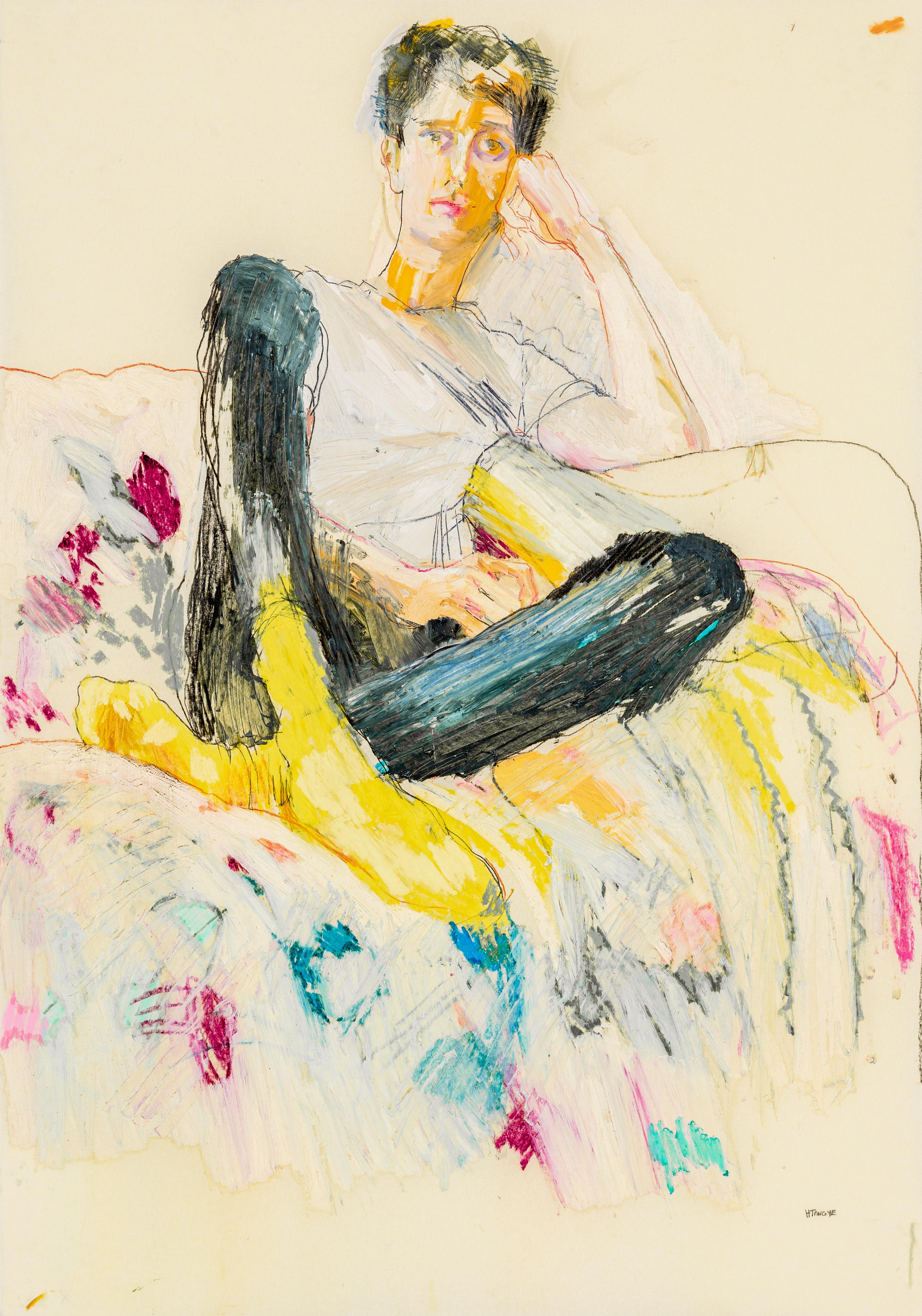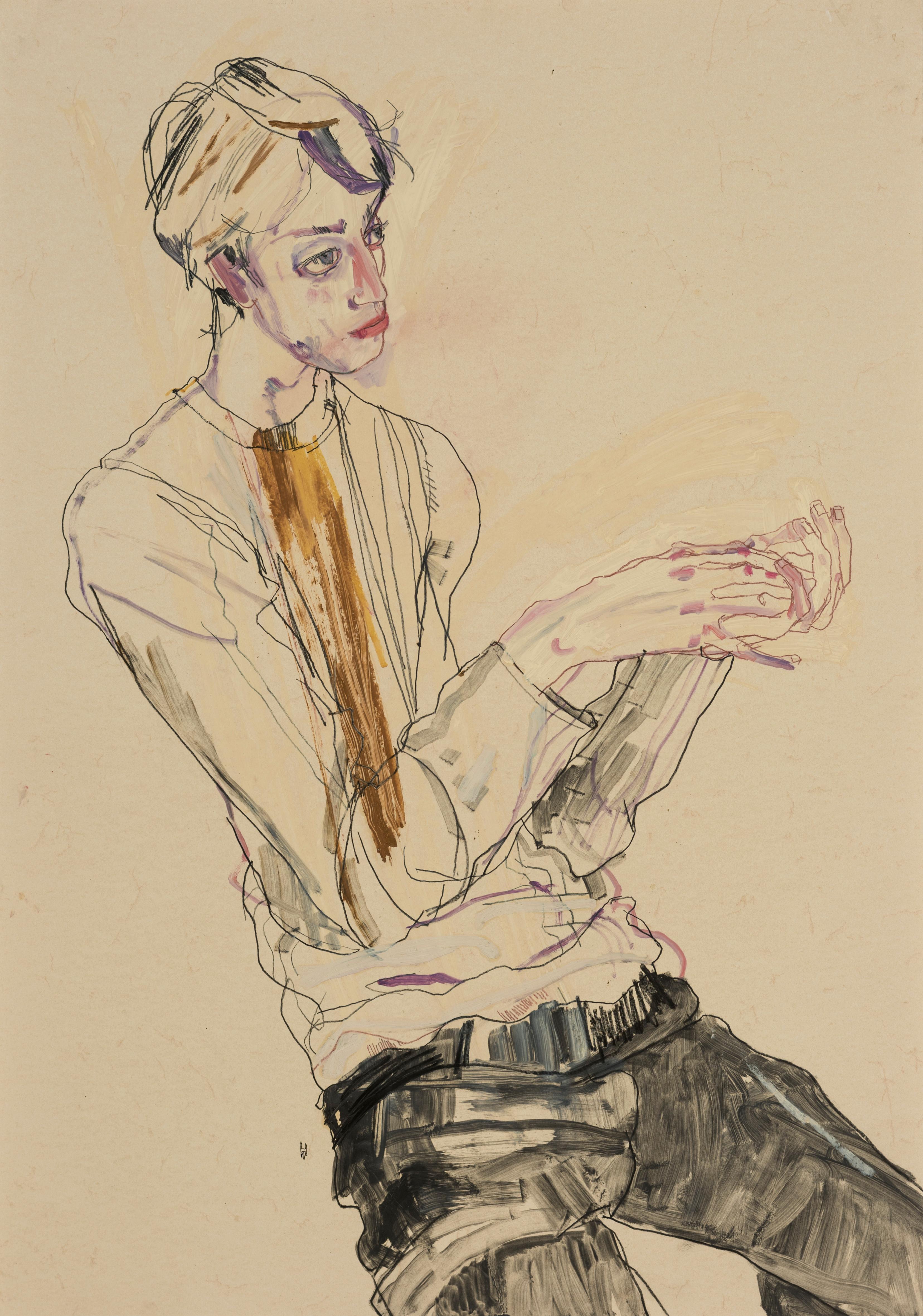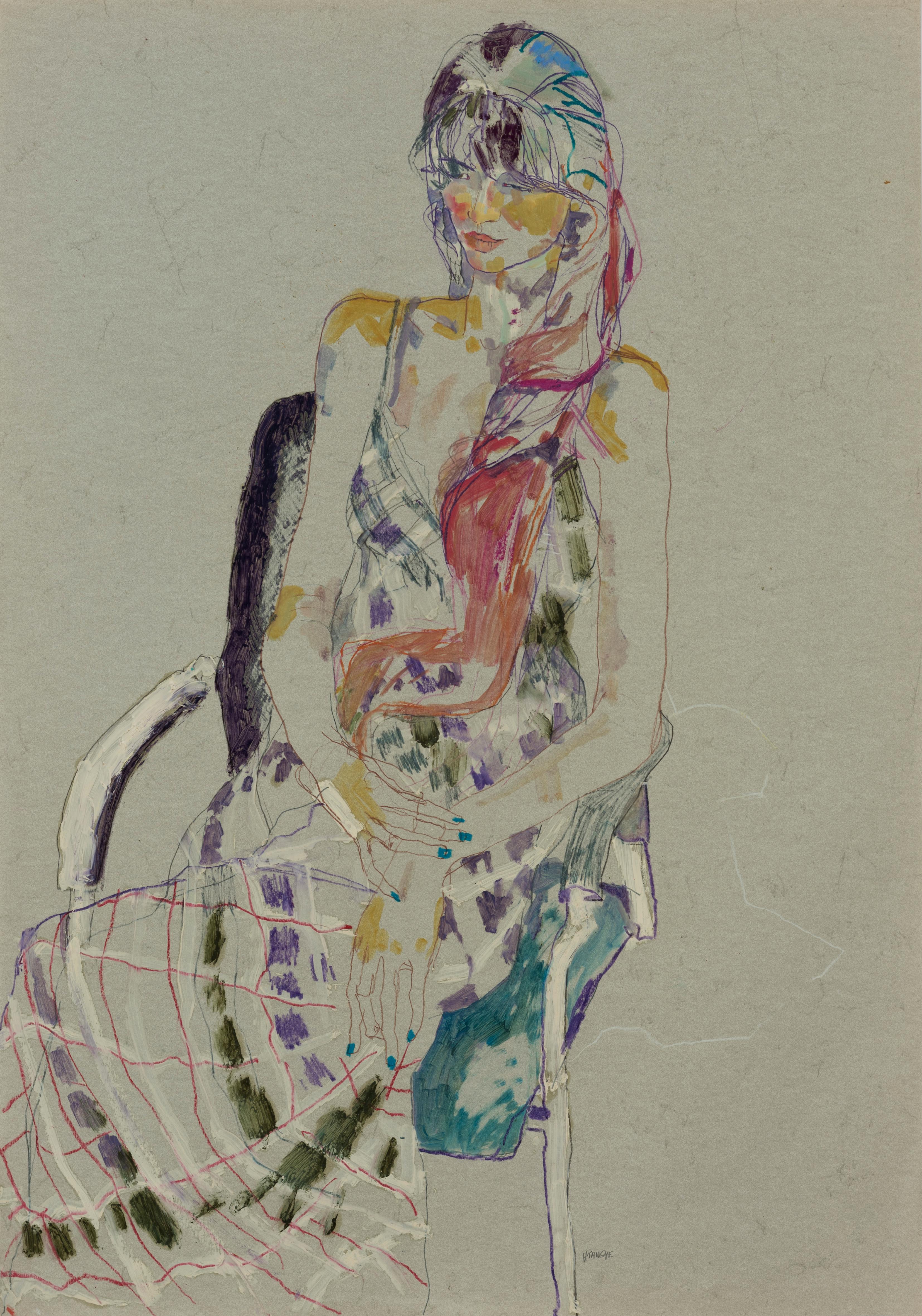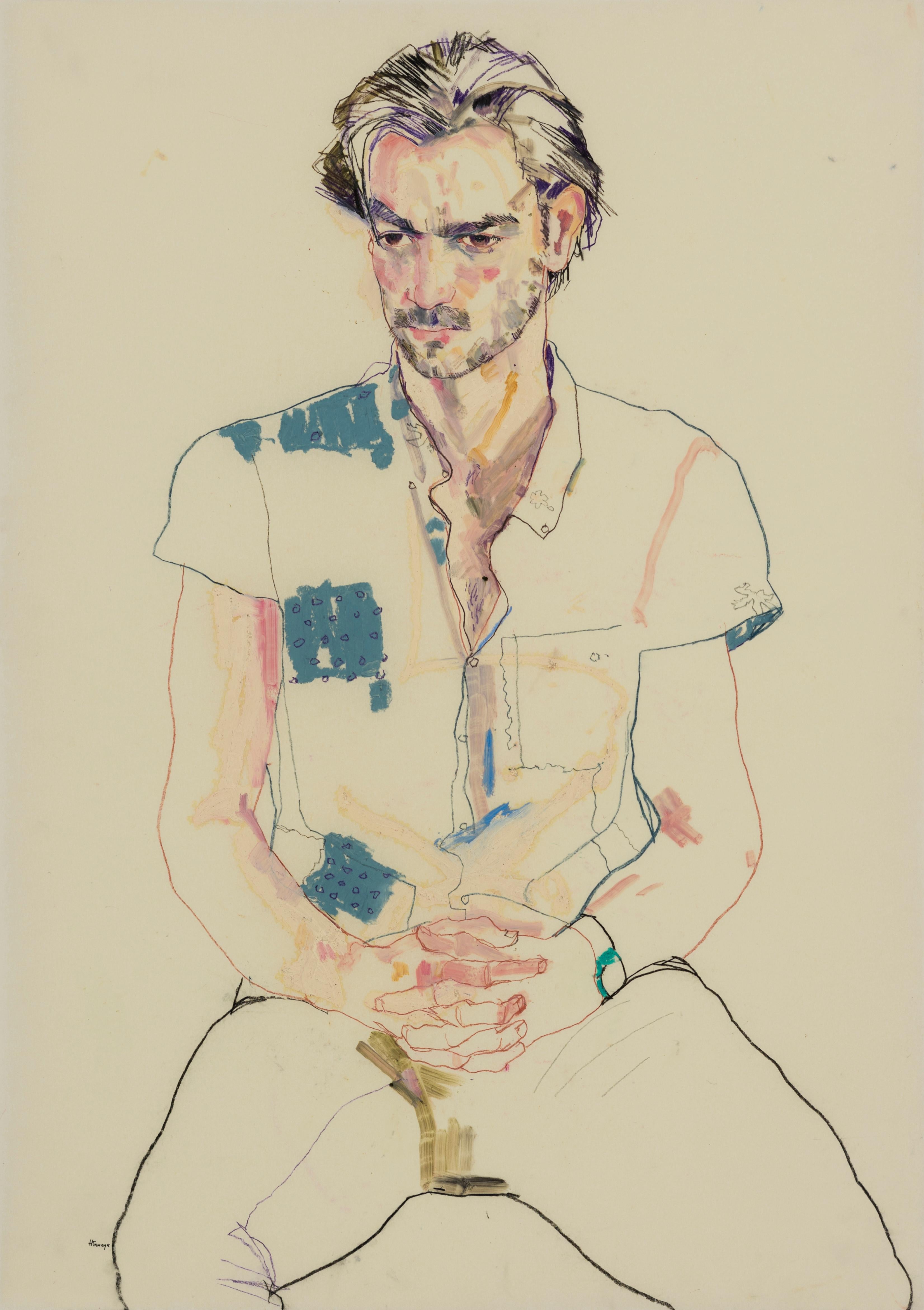Items Similar to Portrait of a man, an expressionist drawing by László Moholy-Nagy
Want more images or videos?
Request additional images or videos from the seller
1 of 4
László Moholy-NagyPortrait of a man, an expressionist drawing by László Moholy-Nagy1919-1920
1919-1920
About the Item
This recently rediscovered expressionist drawing by László Moholy-Nagy is part of a small group of drawings made by the artist early in his career, in Vienna and Berlin. The use of interlaced curves, typical of the artist's technique, gives this hieratic portrait a magnetic radiance, while the absence of any connection with the rest of the body evokes a profane Holy Face.
1. From Hungary to Chicago, the ardent life of László Moholy-Nagy
Moholy-Nagy was born in Borsod, now known as Bácsborsód in Southern Hungary, in July 1895. He studied law in Budapest in 1913, when he was drafted into the Austro-Hungarian army to serve as an artillery officer on the Italian and Russian fronts. While serving at artillery observation posts, Moholy-Nagy was able to execute numerous drawings, recording his traumatic war experience, on the reverse of military-issued postcards which he could easily carry with him. In 1917, he was seriously wounded and hospitalized. The following year (around 1918 at the age of 23), he abandoned his plans to become a lawyer in favour of a career as an artist, with the encouragement of his friend, the art critic Iván Hevesy.
The drawings executed in those early years reveal Moholy-Nagy's powerful Expressionist lines. In his autobiography of 1944, Abstract of an Artist, Moholy-Nagy explained his early figurative style, writing that contemporary art in those days was too chaotic and that and all the '-isms' were incomprehensible and puzzling to him.
He was, however, experimenting with Dadaist compositions already in 1919 and then moved to Vienna and later to Berlin, where he would soon make his first works in his Constructivist style of the early 1920s.
In Berlin he met photograph and writer Lucia Schultz who became his wife the next year. In 1922 he met Walter Gropius. During a vacation on the Rhome with Lucia, she introduced him to making photograms on light-sensitized paper. Walter Gropius invited him to teach at the Bauhaus in Weimar in 1923 where he replaced Paul Klee as Head of the Metal Workshop. The Bauhaus became known for the versatility of its artists and Moholy-Nagy was no exception: throughout his career, he became proficient in the fiels of photography, typography, sculpture, painting, printmaking, film-making and industrial design.
In 1928 Moholy-Nagy left the Bauhaus and established his own design studio in Berlin. He separated from his first wide Lucia in 1929. In 1931 he met actress and scriptwriter Sibylle Pietzsch. They married in 1932 and has two daughters, Hattula (born 1933) and Claudia. After the Nazis came to power in Germany in 1933, he was no longer allowed to work there. He moved his family to London in 1935. In 1937, on the recommendation of Walter Gropius, Moholy-Nagy moved to Chicago to become the director of the New Bauhaus, but the school closed in 1938. Moholy-Nagy resumed doing commercial design work, which he continued for the rest of his life.
In 1939 Moholy-Nagy opened the School of Design in Chicago, which became in 1944 the Institute of Design, becoming part of the Illinois Institute of Technology in 1949. Diagnosed with leukemia in 1945, Moholy-Nagy died of the disease in Chicago in 1946.
2. Description of the artwork
This drawing presents us with a frontal representation of a man in his thirties, whose penetrating gaze seems to stare at us. The face is highly symmetrical and is modelled by curved black lines. The very high forehead and the slightly dilated left pupil reinforce the very expressive character of the face.
Like the Holy Face which appeared on the cloth stretched out to wipe Christ's face by Saint Veronica, only the model's face is represented on the cardboard piece. The curved lines that define the face, hollowing out the temples, the eyelids, the cheeks and the area around the mouth, create a kind of magnetic radiation around a median point located between the eyebrows.
In some respects, this face may evoke one of the most famous representations of the Holy Face: the extraordinary engraving by Claude Mellan (1598 - 1688) which has been engraved with a single rotating line starting from the tip of Christ's nose.
3. Related works
The technique of this drawing, based on the use of intersecting curves, evokes other portraits made by the artist in the years 1918 -1920, starting with his self-portrait made in 1918 (sold by Sotheby's London for £145,200 on 23 June 2010).
Usually drawn with a wax crayon, sometimes with charcoal or graphite, the few portraits we have been able to find in the sale catalogues do not have the hieratic character of the one we are presenting: the sitter is generally represented in a three-quarter view, in mid-bust.
The portrait sold at Bonhams on 11 October 2018 is probably the one that seems closest to our work, although it was done with a different medium (charcoal) and also in mid-bust.
We were unable to identify the sitter of our portrait. The narrow moustache and the flattened hair are typical of the male canons of the 1920s, as seen, for example, in this photographic portrait of Herbert Bayer (1900 - 1985), which Moholy-Nagy made a few years after our portrait.
Our portrait was made on a sheet of strong cardboard about 3 mm thick. We chose not to frame it at this stage, keeping the drawing as a modern icon on cardboard.
- Creator:László Moholy-Nagy (1895 - 1946, Hungarian)
- Creation Year:1919-1920
- Dimensions:Height: 13.13 in (33.36 cm)Width: 8.25 in (20.96 cm)
- Medium:
- Movement & Style:
- Period:
- Condition:Black wax crayon on cardboard 13 1/8” x 8 ¼” (333 x 210 mm) Unframed We wish to thank Mrs Hattula Moholy-Nagy who kindly confirmed the authenticity of this work on the basis of digital photographs.
- Gallery Location:PARIS, FR
- Reference Number:1stDibs: LU1568210582502
About the Seller
5.0
Vetted Seller
These experienced sellers undergo a comprehensive evaluation by our team of in-house experts.
Established in 2020
1stDibs seller since 2021
8 sales on 1stDibs
Typical response time: 2 hours
- ShippingRetrieving quote...Ships From: PARIS, France
- Return PolicyA return for this item may be initiated within 3 days of delivery.
More From This SellerView All
- Costume of an envoy of Venice, a drawing by Francesco Galimberti (1755 - 1803)Located in PARIS, FRWe thank Mrs. Bożena Anna Kowalczyk who suggested the attribution to Francesco Galimberti based on a photograph of the artwork. This engaging drawing, finely executed in black and red chalks, depicts a Venetian diplomat in his 'new clothes...Category
1780s Old Masters Portrait Drawings and Watercolors
MaterialsChalk
- Portrait of a Melancholic Woman, a Drawing signed by Léon BonnatLocated in PARIS, FRThis drawing by Léon Bonnat, the greatest portrait painter of the Third Republic, shows a woman of indeterminate age, caught in a melancholic pose. 1. Léo...Category
Late 19th Century Romantic Portrait Drawings and Watercolors
MaterialsCardboard, Carbon Pencil
- Portrait of a Lady, Drawing Signed and Dated by Augustin de Saint-AubinBy Augustin de Saint-AubinLocated in PARIS, FRThis drawing full of freshness presents us with the profile of an elegant lady, drawn by Augustin de Saint-Aubin on a beautiful summer day in 1776, during the early months of Louis X...Category
1770s Old Masters Portrait Drawings and Watercolors
MaterialsPastel, Pencil
- Portrait of a Newlywed by Casper Casteleyn, an artist of the Dutch Golden AgeLocated in PARIS, FRThis marvelous portrait on vellum is the work of a rare Dutch Golden Age artist, Casper Casteleyn, who has also drawn a closely related portrait now at the Fondation Custodia in Pari...Category
17th Century Old Masters Portrait Drawings and Watercolors
MaterialsVellum, Chalk
- The Arab Butcher, a preparatory drawing by Gustave Guillaumet (1840 - 1887)Located in PARIS, FRThis intensely expressive figure is a preparatory study for "Arab Market on the Tocria Plain", a painting exhibited at the 1865 Salon and now in the Musée des Beaux-Arts in Lille. 1...Category
1860s Old Masters Figurative Drawings and Watercolors
MaterialsCarbon Pencil, Chalk
- Modello for the Virgin of the Rosary, a drawing by Francesco Vanni (1563 - 1610)Located in PARIS, FRFrancesco Vanni is one of the last representatives of the long Sienese pictorial tradition. In this masterly composition in pen and ink wash, he presents the Virgin of the Rosary, holding the Child Jesus on her lap, surrounded on her right by Saint Dominic and on her left by Saint Catherine of Siena. The presence of these two emblematic saints of the Dominican order is a reminder of the devotion of this order to the Rosary. 1. Francesco Vanni, a Sienese painter of the Counter-Reformation Francesco Vanni was the most important Sienese painter of the late sixteenth century and a key Italian Counter-Reformation painter. He developed a very specific style, inspired not by Florentine models but rather by the Roman, Bolognese and Marche schools, and in particular by the work of his contemporary Federico Barocci (Urbino 1535 - 1612), despite the two artists never meeting. Francesco Vanni was born in Siena around 1563-1564. His father died in 1567 and his mother remarried Arcangelo Salimbeni (1536 - 1579), then one of Siena’s leading painters. His half-brother Ventura Salembini (1568 - 1613) also became a well-known painter. He continued his apprenticeship in Bologna and Rome, where he joined the painter Giovanni de Vecchi’s (1536 - 1614) studio, where he was greatly influenced, like other Tuscan painters of the time, by the art of Federico Barocci. He devoted himself mainly to religious painting, following the canons of the Counter-Reformation. Travelling between Siena, Rome, Bologna and Parma, in 1604, he settled in Siena, where he ended his life. Vanni was also an important member of the Confraternity of the Sacro Chiodo, renowned for its demanding religious practices. His legacy also includes some important engraved work. 2. Description of the artwork The Virgin is depicted enthroned in majesty, slightly taller than the other figures that she dominates from her pedestal. Her wide robe with marked folds evokes Renaissance statuary. She is crowned by two angels in the sky. These two angels are a reminder of the custom of adding angels to crown 13th century icons which was frequent at Vanni’s time. The Child Jesus is standing on the Virgin’s right knee. With her left hand she holds out a rosary to Catherine of Siena, identifiable by a branch of lily in her hand. In a symmetrical gesture, the Child Jesus also holds out a rosary to St Dominic. Two of St Dominic’s attributes are to be found at the foot of the Virgin: a book and a branch of lilies. Vanni gives particularly delicate treatment to St. Dominic's long and slender hands. The two outstretched rosaries form the link between the heavenly register of the Virgin and the Child Jesus and the earthly register of the two Dominicans who are not crowned with a halo. This and the fact they are followed by a large crowd, indicates that they are both represented as part of the multitude of the living called to pray to the Rosary. According to the classical iconographic tradition, it would be plausible to consider that the figure looking at the viewer on the extreme left of the drawing could be a self-portrait of the painter. Francesco Vanni's face is known to us from a self-portrait kept in the Pinacoteca Nazionale in Siena. The squaring of the drawing suggests that it was used for a larger-scale altarpiece, probably for a church dedicated to St Dominic or for a Dominican convent. As of today, we have not identified the painting for which this drawing served as a preparatory modello. The Madonna of the Rosary in the Cathedral of Pitigliano (painted by Francesco Vanni in 1609) differs quite significantly from our drawing by the addition of Pope Pius V, and the inclusion of St. Dominic and St. Catherine in the celestial register. We believe that our drawing predates this painting because of its more symmetrical composition, and less Baroque influence. The presence of Saint Catherine of Siena, particularly venerated in his native town, to which Francesco Vanni returned frequently from 1590 onwards, leads us to propose a date of around 1590 - 1600 for this drawing. 3. The Rosary and the Dominican Order In order to clarify the iconographic meaning of this artwork, it is worth recalling the role of Saint Dominic in the spread of the Rosary prayer. Dominic Nuñez de Guzman was born around 1170 in Caleruega (near Burgos) in Spain and died in 1221 in Bologna, Italy. He was the founder of the order of friar preachers, commonly known as the Dominicans. He was canonised by the Church in 1234 and has since been celebrated under the name of Saint Dominic. After three days of prayer in the forest of Bouconne, near Toulouse, Dominic is said to have received the Rosary as a means of converting the Cathar population. The Dominicans subsequently made a special effort to promote this form of meditative prayer. Pope Pius V, a Dominican, included the feast of the Rosary (on October 7th) in the liturgical calendar in 1571. Rosary prayer has evolved over the centuries and traditionally consists of the recitation of three rosaries (four since St John Paul II). Each rosary consists of five tens of "Hail Mary...Category
16th Century Old Masters Figurative Drawings and Watercolors
MaterialsPen, Ink
You May Also Like
- Nobu (Looking Down), Mixed Media on Pergamenata parchmentBy Howard TangyeLocated in London, GBHoward Tangye (b.1948, Australia) has been an influential force in fashion for decades. Lecturing at London’s Central Saint Martins for 35 years, including 16 years as head of BA Wom...Category
2010s Contemporary Portrait Drawings and Watercolors
MaterialsPaint, Paper, Parchment Paper, Charcoal, Crayon, Oil Crayon, Oil Pastel,...
- Tom (Sitting, flowers, through Zoom), Mixed media on Pergameneta parchmentBy Howard TangyeLocated in London, GBHoward Tangye (b.1948, Australia) has been an influential force in fashion for decades. Lecturing at London’s Central Saint Martins for 35 years, including 16 years as head of BA Wom...Category
2010s Contemporary Figurative Paintings
MaterialsPaint, Paper, Parchment Paper, Charcoal, Crayon, Oil Crayon, Oil Pastel,...
- Ben Waters (Seated, Hand Holding), Mixed media on Pergamenata parchmentBy Howard TangyeLocated in London, GBHoward Tangye (b.1948, Australia) has been an influential force in fashion for decades. Lecturing at London’s Central Saint Martins for 35 years, including 16 years as head of BA Wom...Category
2010s Contemporary Figurative Paintings
MaterialsGesso, Paint, Paper, Parchment Paper, Charcoal, Crayon, Oil Crayon, Oil ...
- Moira C. (Sitting - Long Red Hair), Mixed media on grey parchmentBy Howard TangyeLocated in London, GBHoward Tangye (b.1948, Australia) has been an influential force in fashion for decades. Lecturing at London’s Central Saint Martins for 35 years, includi...Category
2010s Contemporary Portrait Drawings and Watercolors
MaterialsPaint, Paper, Parchment Paper, Charcoal, Crayon, Oil Crayon, Oil Pastel,...
- George (Sitting - Black, White and Grey), Mixed media on Pergamenata parchmentBy Howard TangyeLocated in London, GBHoward Tangye (b.1948, Australia) has been an influential force in fashion for decades. Lecturing at London’s Central Saint Martins for 35 years, including 16 years as head of BA Wom...Category
2010s Contemporary Portrait Drawings and Watercolors
MaterialsPaint, Paper, Parchment Paper, Charcoal, Crayon, Oil Crayon, Oil Pastel,...
- Francesco (Blue Trousers), Mixed media on Pergamenata parchmentBy Howard TangyeLocated in London, GBHoward Tangye (b.1948, Australia) has been an influential force in fashion for decades. Lecturing at London’s Central Saint Martins for 35 years, including 16 years as head of BA Womenswear. There, he tutored many contemporary greats, including John Galliano, Stella McCartney, Christopher Kane, Wes Gordon, Zac Posen and Hussein Chalayan. Examples of Tangye’s portraits are held in many important collections, both public and private, including the Victoria and Albert Museum (V&A), Harvard University and London’s National Portrait Gallery. Throughout his teaching career Tangye quietly developed a particularly idiosyncratic art practice. By employing a decisive line with bold applications of richly layered materials, Tangye explores the nuances of the human form in an effort to expose his subjects’ true essence and energy. — Howard Tangye Francesco (Blue Trousers...Category
2010s Contemporary Figurative Paintings
MaterialsOil Pastel, Pastel, Wax Crayon, Mixed Media, Oil, Acrylic, Watercolor, G...





